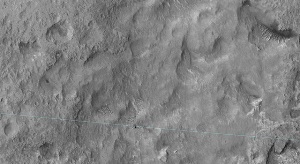Jul 11 2014
NASA Mars rover Curiosity has driven out of the ellipse, approximately 4 miles wide and 12 miles long (7 kilometers by 20 kilometers), that was mapped as safe terrain for its 2012 landing inside Gale Crater.
 This June 27, 2014, image from the HiRISE camera on NASA's Mars Reconnaissance Orbiter shows NASA's Curiosity Mars rover on the rover's landing-ellipse boundary, which is superimposed on the image. The 12-mile-wide ellipse was mapped as safe terrain for its 2012 landing inside Gale Crater. Image Credit: NASA/JPL-Caltech/Univ. of Arizona
This June 27, 2014, image from the HiRISE camera on NASA's Mars Reconnaissance Orbiter shows NASA's Curiosity Mars rover on the rover's landing-ellipse boundary, which is superimposed on the image. The 12-mile-wide ellipse was mapped as safe terrain for its 2012 landing inside Gale Crater. Image Credit: NASA/JPL-Caltech/Univ. of Arizona
The High Resolution Imaging Science Experiment (HiRISE) camera on NASA's Mars Reconnaissance Orbiter photographed the rover on June 27 at the end of a drive that put Curiosity right on the ellipse boundary. An image from that observation is online at: http://www.jpl.nasa.gov/spaceimages/details.php?id=PIA18399
The landing ellipse is the area within which the rover had a very high probability of touching down when it arrived at Mars on Aug. 5, 2012, PDT (Aug. 6, UTC). The area needed to meet requrements for providing access to scientifically interesting sites while presenting few landing hazards, such as steep slopes or large boulders. Many areas of scientific interest have slopes ineligible for landing safety, and Curiosity was designed to have the capability of driving far enough to get to slopes ouside of the landing ellipse. Since landing, Curiosity has driven slightly more than 5 miles (8 kilometers).
NASA's Mars Science Laboratory Project is using Curiosity to assess ancient habitable environments and major changes in Martian environmental conditions. NASA's Jet Propulsion Laboratory, a division of the California Institute of Technology, Pasadena, manages the Mars Reconnaissance Orbiter and Mars Science Laboratory projects for NASA's Science Mission Directorate in Washington. HiRISE is operated by the University of Arizona, Tucson. The instrument was built by Ball Aerospace & Technologies Corp., Boulder, Colorado.
For more information about the Mars Reconnaissance Orbiter, which has been studying Mars from orbit since 2006, visit http://www.nasa.gov/mro
For more information about Curiosity, visit http://www.jpl.nasa.gov/msl, http://www.nasa.gov/msl and http://mars.jpl.nasa.gov/msl/
You can follow the mission on Facebook at https://www.facebook.com/marscuriosity and on Twitter at http://www.twitter.com/marscuriosity